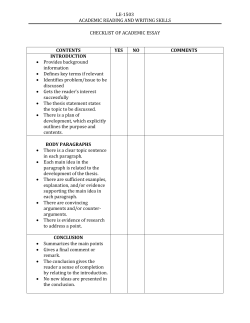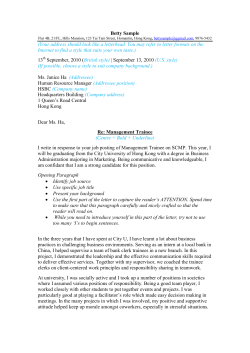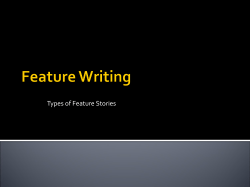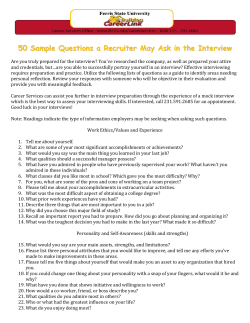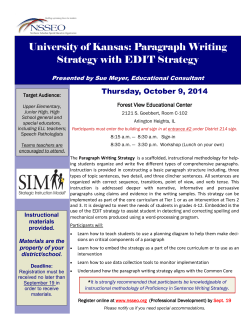
Immigrant Biography Project
Immigrant Biography Project Interview and Biography Writing © OzCurriculum HQ 2013 1 Teacher Notes This project requires students to plan and carry out an interview with an immigrant. The information gained from the interview is then used to write a biography. Content Descriptions Historical Knowledge and Understanding: Australia as a Nation Stories of groups of people who migrated to Australia (including from ONE Asian country) and the reasons they migrated, such as World War II and Australian migration programs since the war. (ACHHK115) Historical Skills: Historical questions and research Identify and locate a range of relevant sources (ACHHS120) Historical Skills: Explanation and communication Develop texts, particularly narratives and descriptions, which incorporate source materials (ACHHS124) © OzCurriculum HQ 2013 2 Planning Your Interview Who are you going to interview? Why? Brainstorm some questions to ask in the interview. Questions to Ask What do you need to do to organise your interview? © OzCurriculum HQ 2013 3 Name: Date: Conducting Your Interview Write your questions and the answers you are given into the table below. Question © OzCurriculum HQ 2013 Interviewee Response 4 Biography Informs readers about the significant events of a person’s life Structure of a Biography Orientation Events in Chronological Order Re-orientation Language Features of a Biography Written in past tense Written in 3rd person Action verbs Time order signal words Cause and effect signal words © OzCurriculum HQ 2013 5 Name: Date: Planning Your Biography of a Migrant Organise the notes from your interview into this table Title: Orientation: Name of the person and some basic details about their life and migration. Series of Events: Important events of the person’s life in chronological order. Focus on details of their migration. Think about their life before migration, details of the migration and their life after migration. Re-orientation: Restate why the migrant’s experiences are significant for us to know about. Also include details of their life now and their feelings about migrating. © OzCurriculum HQ 2013 6 Name: Date: Writing Your Biograpghy Title: (Name of Person and Years of Birth-Death) Orientation: Name the person and introduce basic details about their life and migration. Paragraph 1 Series of Events: Give details about the important events of the person’s life, in chronological order. Paragraph 2 - Before Migration © OzCurriculum HQ 2013 7 Paragraph 3 - Migration Paragraph 4 - After Migration Paragraph 5 - Additional Information Re-Orientation: Restate why the migrant’s experiences are significant and give details of their feelings about migration. Last Paragraph © OzCurriculum HQ 2013 8 Name: Date: Editing Your Biograpghy Text Structure Check if these parts are included Title that tells person’s name and year of birth Orientation that tells the reader who the biography is about and the reasons they are significant. Body of at least 3 paragraphs outlining the significant events of the person’s life in chronological order. Re-orientation that tells why the person’s experiences are significant Spelling, Grammar and Puntuation Check if you have proofread for these and edited where needed Underline spelling errors and find the correct spelling Insert missing words Cross out repeated words Each sentence makes sense Commas in the correct places All proper nouns have capital letters All sentencs begin with a capital letter All sentences end with a full stop Language Features Check for these and give an example from your writing Feature Check Example Written in past tense Written in 3rd person Time order signal words Cause and effect signal words Action verbs © OzCurriculum HQ 2013 9 Name: Date: Learning From Your Interview and Biograpghy Reflection on the project Who did you choose to interview and why? Do you think they were a good person to interview? Give reasons. Do you think you asked good quality questions? Give reasons. What was the most interesting thing you learned from the person you interviewed? If you were asked to do this activity again, what would you do differently? 1. 2. 3. What have you learned about Australian immigration from completing this activity? © OzCurriculum HQ 2013 10 © OzCurriculum HQ 2013 11 A Support and engage the reader through deliberate and effective language choices. Coherent, controlled and complete biographical text, with all components well developed. Ideas are generated, selected and crafted to be highly informative. A range of subject-specific, effective words and word groups is used in a fluent and articulate manner. A highly cohesive piece of writing showing continuity of ideas and tightly linked sections of text. Paragraphs are ordered and cumulatively build information across the text. Writing contains controlled and well-developed sentences that express precise meaning and are consistently effective. Writing contains accurate use of all applicable punctuation. Correct spelling of all simple and common words and at least 10 difficult words and some challenging words. Criteria Audience Text Structure Ideas Vocabulary Cohesion Paragraphing Sentence Structure Punctuation Spelling Some use of subject-specific words or word groups. Ideas are supported with some elaboration. All components of the biographical text are present but weak Contains sufficient information for the reader to follow the text fairly easily. C Correct spelling of simple words, most common words at least 10 difficult words. All sentence punctuation is correct and mostly correct use of other punctuation. All simple, compound and complex sentences are correct and meaning is clear. All paragraphs are focused on one idea or set of like ideas. Links are missing or incorrect and text is often confusing for the reader. Has used mainly simple words, with limited use of precise words or word groups. Many simple ideas that are related but not elaborated. Minimal evidence of biographical text structure Attempts to orient the reader and provides some information to support reader understanding. D Correct spelling of simple words, most common words some difficult words. Sentence level punctuation mostly correct and some other correct punctuation. Most simple and compound sentences are correct and some complex sentences are correct. Correct spelling of most simple words and some common words. Correct use of capital letters to start sentences and full stops to end sentences. Punctuation is minimal and of little assistance to the reader. Some correct formation of simple and complex sentences. Writing is organised into paragraphs No correct use of paragraphing. that are mainly focused on one idea or set of like ideas. Meaning is clear on first reading and Some correct links between text flows well throughout the piece sentences and cohesion controlled of writing. only in parts. Sustained and consistent use of subject-specific words and word groups that enhance meaning. Ideas are elaborated and contribute effectively to the understanding of the subject. Detailed biographical text with some well developed components and some weaker components. Supports reader understanding and is beginning to engage the reader through language choices. B Assessing Your Biography Thankyou for downloading my product This file is intended for your personal classroom use and must not be redistributed Please contact me with any questions, concerns or requests mailbox@ozcurriculumhq.com.au Follow me TpT Store Blog Facebook Pinterest Graphics and Fonts KPM Doodles Jen Jones Hello Literacy Kimberly Geswein Fonts Teaching in a Small Town Julie Phillipps © OzCurriculum HQ 2013 12
© Copyright 2025
